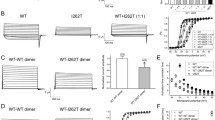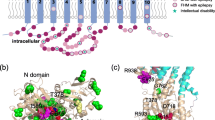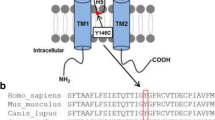Abstract
Mutations in the KCNK18 gene that encodes the TRESK K2P potassium channel have previously been linked with typical familial migraine with aura. Recently, an atypical clinical case has been reported in which a male individual carrying the p.Trp101Arg (W101R) missense mutation in the KCNK18 gene was diagnosed with intellectual disability and migraine with brainstem aura. Here we report the functional characterization of this new missense variant. This mutation is located in a highly conserved residue close to the selectivity filter, and our results show although these mutant channels retain their K+ selectivity and calcineurin-dependent regulation, the variant causes an overall dramatic loss of TRESK channel function as well as an initial dominant-negative effect when co-expressed with wild-type channels in Xenopus laevis oocytes. The dramatic functional consequences of this mutation thereby support a potentially pathogenic role for this variant and provide further insight into the relationship between the structure and function of this ion channel.





Similar content being viewed by others
References
Andres-Enguix I, Shang L, Stansfeld P et al (2012) Functional analysis of missense variants in the TRESK (KCNK18) K+ channel. Sci Rep 2:237. https://doi.org/10.1038/srep00237
Bautista DM, Sigal YM, Milstein AD, Garrison JL, Zorn JA, Tsuruda PR, Nicoll RA, Julius D (2008) Pungent agents from Szechuan peppers excite sensory neurons by inhibiting two-pore potassium channels. Nat Neurosci 11(7):772–779. https://doi.org/10.1038/nn.2143
Czirjak G, Enyedi P (2006) Targeting of calcineurin to an NFAT-like docking site is required for the calcium-dependent activation of the background K+ channel, TRESK. J Biol Chem 281:14677–14682
Czirjak G, Toth ZE, Enyedi P (2004) The two-pore domain K+ channel, TRESK, is activated by the cytoplasmic calcium signal through calcineurin. J Biol Chem 279:18550–18558
D'Adamo MC, Gallenmüller C, Servettini I et al (2015) Novel phenotype associated with a mutation in the KCNA1(Kv1.1) gene. Front Physiol 5:525. https://doi.org/10.3389/fphys.2014.00525
D'Adamo MC, Hasan S, Guglielmi L et al (2015) New insights into the pathogenesis and therapeutics of episodic ataxia type 1. Front Cell Neurosci 9:317. https://doi.org/10.3389/fncel.2015.00317
Enyedi P, Czirják G (2010) Molecular background of leak K+ currents: two-pore domain potassium channels. Physiol Rev 90:559–605. https://doi.org/10.1152/physrev.00029.2009
Enyedi P, Czirják G (2015) Properties, regulation, pharmacology, and functions of the K2p channel, TRESK. Pflugers Arch 467(5):945–958. https://doi.org/10.1007/s00424-014-1634-8
Guglielmi L, Servettini I, Caramia M, Catacuzzeno L, Franciolini F, D’Adamo MC, Pessia M (2015) Update on the implication of potassium channels in autism: K+ channelautism spectrum disorder. Front. Cell Neurosci 9:34. https://doi.org/10.3389/fncel.2015.00034
Guo Z, Qiu CS, Jiang X, Zhang J, Li F, Liu Q et al (2019) TRESK K+ channel activity regulates trigeminal nociception and headache. eNeuro 6(4):ENEURO.0236-19.2019. https://doi.org/10.1523/ENEURO.0236-19.2019
Han JY, Jang JH, Park J, Lee IG (2018) Targeted next-generation sequencing of Korean patients with developmental delay and/or intellectual disability. Front Pediatr 6:391. https://doi.org/10.3389/fped.2018.00391
Imbrici P, Cusimano A, D'Adamo MC, De Curtis A, Pessia M (2003) Functional characterization of an episodic ataxia type-1 mutation occurring in the S1 segment of hKv1.1 channels. Pflugers Arch 446(3):373–379. https://doi.org/10.1007/s00424-002-0962-2
Imbrici P, D'Adamo MC, Cusimano A, Pessia M (2007) Episodic ataxia type 1 mutation F184C alters Zn2+−induced modulation of the human K+ channel Kv1.4 Kv1.1/Kvbeta1.1. Am J Physiol Cell Physiol 292(2):C778–C787. https://doi.org/10.1152/ajpcell.00259.2006
Imbrici P, Gualandi F, D'Adamo MC, Masieri MT, Cudia P, de Grandis D, Mannucci R, Nicoletti I, Tucker SJ, Ferlini A, Pessia M (2008) A novel KCNA1 mutation identified in an Italian family affected by episodic ataxia type 1. Neuroscience 157(3):577–587. https://doi.org/10.1016/j.neuroscience.2008.09.022
Imbrici P, D'Adamo MC, Grottesi A, Biscarini A, Pessia M (2011) Episodic ataxia type 1 mutations affect fast inactivation of K+ channels by a reduction in either subunit surface expression or affinity for inactivation domain. Am J Physiol Cell Physiol 300(6):C1314–C1322. https://doi.org/10.1152/ajpcell.00456.2010
Kang D, Kim D (2006) TREK-2 (K2P10.1) and TRESK (K2P18.1) are major background K+ channels in dorsal root ganglion neurons. Am J Physiol Cell Physiol 291(1):C138–C146. https://doi.org/10.1152/ajpcell.00629.2005
Kang D, Mariash E, Kim D (2004) Functional expression of TRESK-2, a new member of the tandem-pore K+ channel family. J Biol Chem 279:28063–28070
Lafrenière RG, Cader MZ, Poulin JF, Andres-Enguix I, Simoneau M, Gupta N, Boisvert K, Lafrenière F, McLaughlan S, Dubé MP, Marcinkiewicz MM, Ramagopalan S, Ansorge O, Brais B, Sequeiros J, Pereira-Monteiro JM, Griffiths LR, Tucker SJ, Ebers G, Rouleau GA (2010) A dominant-negative mutation in the TRESK potassium channel is linked to familial migraine with aura. Nat Med 16(10):1157–1160. https://doi.org/10.1038/nm.2216
Mathie A, Al-Moubarak E, Veale EL (2010) Gating of two pore domain potassium channels. J Physiol 588:3149–3156
Pergel E, Lengyel M, Enyedi P, Czirják G (2019) TRESK (K2P18.1) background Potassium Channel is activated by novel-type protein kinase C via Dephosphorylation. Mol Pharmacol 95(6):661–672. https://doi.org/10.1124/mol.119.116269
Pettingill P, Weir GA, Wei T, Wu Y, Flower G, Lalic T, Handel A, Duggal G, Chintawar S, Cheung J, Arunasalam K, Couper E, Haupt LM, Griffiths LR, Bassett A, Cowley SA, Cader MZ (2019) A causal role for TRESK loss of function in migraine mechanisms. Brain 142(12):3852–3867. https://doi.org/10.1093/brain/awz342
Piechotta PL, Rapedius M, Stansfeld et al (2011) The pore structure and gating mechanism of K2P channels. EMBO J 30(17):3607–3619. https://doi.org/10.1038/emboj.2011.268
Royal P, Andres-Bilbe A, Avalos Prado P et al (2019) Migraine-associated TRESK mutations increase neuronal excitability through alternative translation initiation and inhibition of TREK. Neuron 101:232–45 e6
Sano Y, Inamura K, Miyake A, Mochizuki S, Kitada C, Yokoi H, Nozawa K, Okada H, Matsushime H, Furuichi K (2003) A novel two-pore domain K+ channel, TRESK, is localized in the spinal cord. J Biol Chem 278:27406–27412. https://doi.org/10.1074/jbc.M206810200
Tucker SJ, Pessia M, Moorhouse AJ, Gribble F, Ashcroft FM, Maylie J, Adelman JP (1996) Heteromeric channel formation and Ca2+-free media reduce the toxic effect of the weaver Kir 3.2 allele. FEBS Lett 390(3):253–257. https://doi.org/10.1016/0014-5793(96)00635-7
Weir GA, Pettingill P, Wu Y, Duggal G, Ilie AS, Akerman CJ, Cader MZ (2019) The role of TRESK in discrete sensory neuron populations and somatosensory processing. Front Mol Neurosci 12:170. https://doi.org/10.3389/fnmol.2019.00170
Yoo S, Liu J, Sabbadini M, Au P, Xie GX, Yost CS (2009) Regional expression of the anesthetic-activated potassium channel TRESK in the rat nervous system. Neurosci Lett 465(1):79–84. https://doi.org/10.1016/j.neulet.2009.08.062
Yoshida S, Plant S (1992) Mechanism of release of Ca2+ from intracellular stores in response to ionomycin in oocytes of the frog Xenopus laevis. J Physiol 458:307–318
Acknowledgments
We gratefully acknowledge the financial support of the University of Malta Research, Innovation and Development Trust (RIDT), the Biotechnology and Biological Sciences Research Council (BBSRC), and United Arab Emirates University (Grants n. 31M452 and 31M468).
Author information
Authors and Affiliations
Contributions
PI designed the study, analyzed data, and wrote the paper; ENA performed electrophysiological experiments and analyzed data; SH critically discussed the results and reviewed the literature; SJT and MP critically revised the manuscript and supervised the work; MCD designed the study, supervised the work and wrote the manuscript.
Corresponding author
Ethics declarations
Conflict of interest
The authors have nothing to disclose. No competing financial interests exist.
Additional information
Publisher’s note
Springer Nature remains neutral with regard to jurisdictional claims in published maps and institutional affiliations.
This article is part of the special issue on Channelopathies: from mutation to diseases in Pflügers Archiv—European Journal of Physiology
Rights and permissions
About this article
Cite this article
Imbrici, P., Nematian-Ardestani, E., Hasan, S. et al. Altered functional properties of a missense variant in the TRESK K+ channel (KCNK18) associated with migraine and intellectual disability. Pflugers Arch - Eur J Physiol 472, 923–930 (2020). https://doi.org/10.1007/s00424-020-02382-5
Received:
Revised:
Accepted:
Published:
Issue Date:
DOI: https://doi.org/10.1007/s00424-020-02382-5




